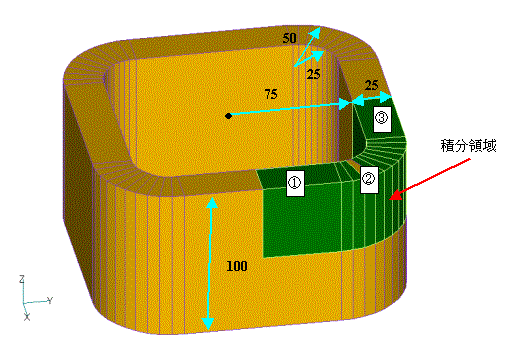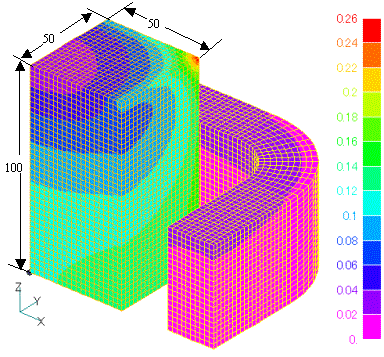COIL inductance and electromagnetic force calculations
- TOP >
- Analysis Examples by Functions (List) >
- COIL inductance and electromagnetic force calculations
Summary
This section introduces how to calculate the inductance and electromagnetic force of an external current magnetic field source (COIL).
Explanation
COIL is a mesh-independent feature that is easy to use. An example of an axisymmetric model is presented in "Inductance calculation for COIL (external current magnetic field source)", but here we will use a model that is 3-dimensional and includes magnetic materials as an example. The accuracy is verified by comparing the two-potential method (A-Ar method), in which the iron core portion is the total potential region and the coil and air portions are the reduced potential regions, with the case in which the entire region is solved with the total potential and the coil is defined with the surface-defined current source SDEFCOIL (A method).
Fig. 1 shows the excitation coil. The coil consists of four rectangular cross sectional straight sections (GCE) and arc sections (ARC). When determining the inductance and electromagnetic force, the integral regions in Fig. 1 are defined by the integral elements GCE- and ARC-. The analysis is performed in the 1/8 domain for symmetry. The integral element is defined as the part of COIL within the analysis domain. The magnetomotive force is set to 3000 AT and a linear static field analysis is performed.
Fig. 2 shows the magnetic flux density intensity distribution obtained with the iron core (specific permeability 1000) and by using the A method. The result is almost the same as obtained using COIL. Table 1 shows the inductance calculation results using the A method. We analyzed the same problem with the boundary condition that Bn=0 and Ht=0 at far boundary. The results are almost the same, and the boundary condition is sufficient. Coil inductance is shown as a one turn equivalent value. The inductance can be calculated either by integrating A・J in the coil region and assuming it equals $LI$, or by taking the total magnetic energy (the total spatial integral of $B^2/2m_0$) as $LI^2/2$. Both methods are in good agreement. In EMSolution, the flux amount of $LI$ is output as the flux of the coil series. We also provide an option to calculate the magnetic energy (MAGNETIC_ENERGY option).
On the other hand, Table 2 shows the results obtained by the A-Ar method. The inductance is calculated and added internally, so the coil inductance includes the iron core effect. In this case, too, the analysis was performed with two types of boundary conditions, and the results are consistent. The results are also consistent with the results obtained by the A method. Without regularization, the ICCG method does not converge to $10^{-8}$, but the results are almost identical.
Table 1. Inductance calculation results using the A method
| boundary condition | unknown number | Number of non-zero elements | ICCG | CPU Time | L (H) A・J Integral | L (H) B×B Integral |
|---|---|---|---|---|---|---|
| Bn=0 | 883,920 | 14,699,871 | 599 | 427.6 | 4.29417E-07 | 4.28800E-07 |
| Ht=0 | 900,260 | 14,973,253 | 431 | 281.0 | 4.30673E-07 | 4.30062E-07 |
| average | 4.30045E-07 | 4.29431E-07 | ||||
Table 2. Inductance calculation results by A-Ar method
| boundary condition | normalization | unknown number | Number of non-zero elements | ICCG | CPU Time | L (H) A・J Integral | |
|---|---|---|---|---|---|---|---|
| Brn=0 | × | 883,920 | 14,699,871 | 545 | 333.1 | 4.30087E-07 | Divergence at 4.2E-07 |
| Brn=0 | 〇 | 883,920 | 14,699,871 | 534 | 342.3 | 4.30087E-07 | |
| Htrt=0 | 〇 | 900,260 | 14,973,253 | 388 | 295.3 | 4.30590E-07 |
Table 3 and 4 show the results of electromagnetic force calculations for both methods, showing the total force in each direction for each section ①, ②, and ③ in Fig. 1. It can be seen that the results of both methods are almost identical.
Table 3. Electromagnetic force calculated by the A method
| Part | Fx ( N ) | Fy ( N ) | Fz ( N ) | |
|---|---|---|---|---|
| Bn=0 | ① | -1.28170E-01 | 2.17279E-07 | -7.67471E-01 |
| ② | -7.38606E-03 | -7.38606E-03 | -8.16667E-01 | |
| ③ | 2.17479E-07 | -1.28170E-01 | -7.67471E-01 | |
| Ht=0 | ① | -1.26507E-01 | 4.01467E-07 | -7.68262E-01 |
| ② | -5.87456E-03 | -5.87456E-03 | -8.17471E-01 | |
| ③ | 4.01467E-07 | -1.26507E-01 | -7.68262E-01 |
Table 4. Electromagnetic force calculated by the A-Ar method
| Part | Fx ( N ) | Fy ( N ) | Fz ( N ) | |
|---|---|---|---|---|
| Brn=0 | ① | -1.26026E-01 | 0.00000E+00 | -7.67754E-01 |
| ② | -6.03243E-03 | -6.03243E-03 | -8.17493E-01 | |
| ③ | 0.00000E+00 | -1.26026E-01 | -7.67754E-01 | |
| Hrt=0 | ① | -1.27201E-01 | 0.00000E+00 | -7.68253E-01 |
| ② | -6.74528E-03 | -6.74528E-03 | -8.18000E-01 | |
| ③ | 0.00000E+00 | -1.27201E-01 | -7.68253E-01 |
As shown above, the results of the A method with SDEFCOIL and the A-Ar method with COIL are almost in good agreement and both analyses are equivalent. In the above example, the mesh is sufficiently fine and the far boundary is sufficiently far away. However, please note that differences may appear if such conditions are not used.
The rest of this page is for members only.
Analysis Examples by Functions
External current magnetic field source
- About the multi-potential method
- Definition of COIL (external current field source) by hexahedral element mesh
- Magnetic field distribution calculation in a COIL-only model
- Circuit calculation with COIL (external current field source) only
- COIL inductance and electromagnetic force calculations
- Inductance Calculation for COIL (external current magnetic field source)
- Handling of inductance in external current field source (COIL)
- About COIL Move
- Problems with external magnetic field current sources in the case of translational periodicity
- Notes on the use of GCE (rectangular current element)
©2020 Science Solutions International Laboratory, Inc.
All Rights reserved.




